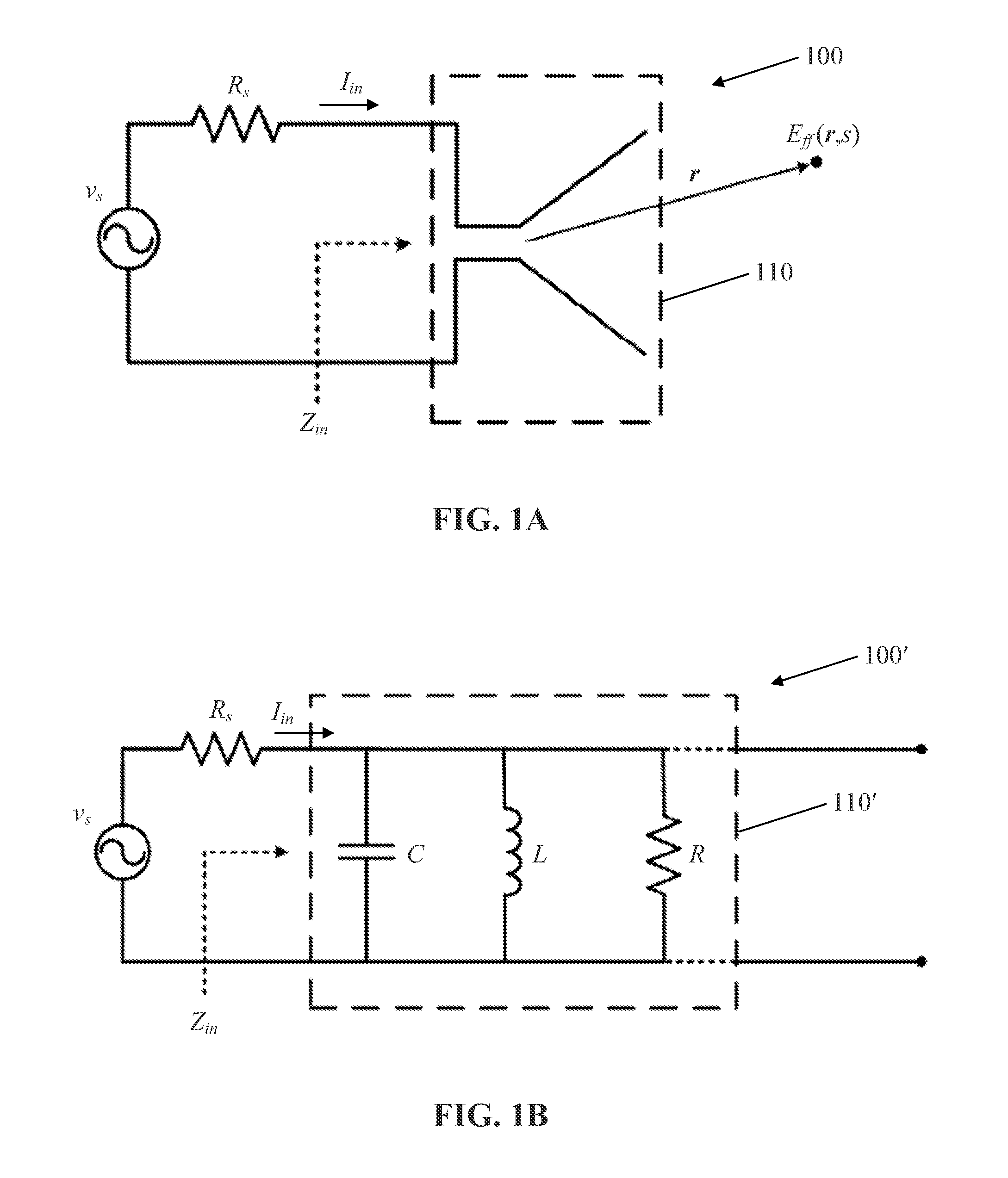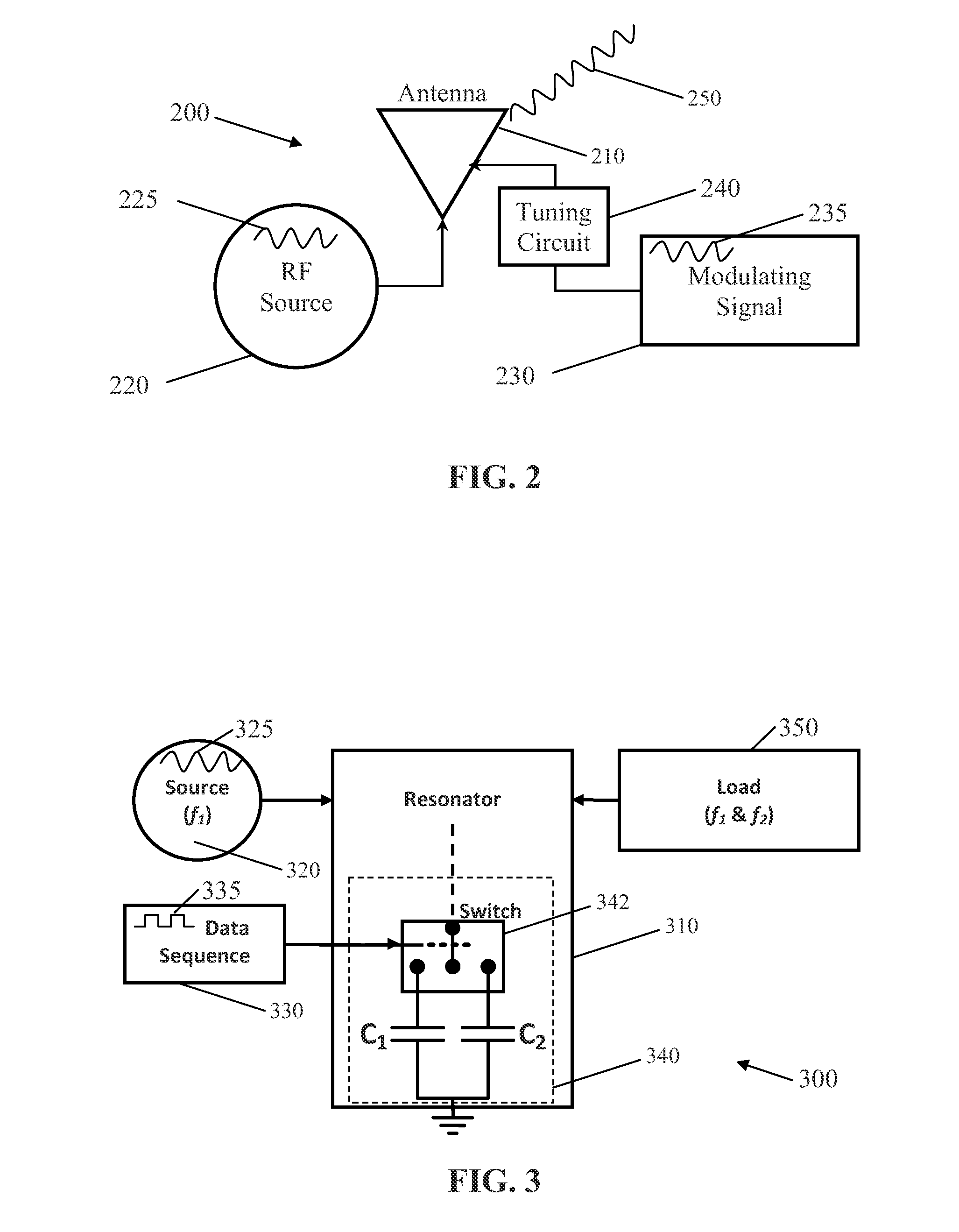A time variant antenna for transmitting wideband signals
a wideband signal and time variant technology, applied in the direction of simultaneous aerial operations, antennas, frequency-modulated carrier systems, etc., can solve the problems of high-bandwidth data transmission, strict follow-up of the fundamental physical limit of the antenna, and significant problems
- Summary
- Abstract
- Description
- Claims
- Application Information
AI Technical Summary
Benefits of technology
Problems solved by technology
Method used
Image
Examples
example 1
[0120]A simulation of the circuit 400 was implemented using Agilent Advance Design System. Component values are chosen to have a high Q resonator with two resonant frequencies f1=500 MHz and f2=300 MHz with Q1=119 and Q2=198 before and after the switching of the capacitor, C2, respectively. A single-pole single-throw voltage-controlled switch was used for the switch 442 to switch the capacitor, C2. A step function signal u(t−ts) was employed to trigger the switch 442 at ts.
[0121]The source signal 425 was programmed to be a sinusoidal voltage signal at 500 MHz with an amplitude of 2 V. FIG. 9A shows the voltage at the load. RL, at ts=400 ns and ts=400.5 ns, which correspond to the zero and maximum crossing of the voltage, respectively. As is depicted in FIG. 9A, right after the switching instant the voltage waveform at the load, RL, shifts to the new resonant frequency, 300 MHz. Also, the magnitude of first peaks for each case agrees with predicted value in Equations 21 and 34.
[0122]...
example 2
[0125]FIGS. 9D and 9E illustrate simulations of FSK signals generated by different switching frequencies of the switch 442, respectively fswitch=50 MHz and fswitch=20 MHz. Since each switching pulse represents a pair of 0 and 1, data rate is twice that of the switching frequency. In fact, by using a fast switching mechanism, a simple narrowband RLC resonator, e.g., that of the circuit 400, excited by a single-tone source. e.g., the source 420, can be employed to generate high data rate FSK signals. The mark frequency is same as the source frequency and the space frequency can be tuned by the switched capacitor, C2. Moreover, by using a variable capacitor, such as a varactor diode, for the capacitor, C1+C2, one can easily tune the space frequency as required.
[0126]A mockup of the circuit 400 has been tested. A PIN diode with 9 ns nominal reverse recovery time was used to create a shunt RF switch for the switch 442. The resonator 410+capacitor, C2, +load, RL, was made of surface mount...
example 3
[0128]Since a high-Q antenna can be characterized by a high-Q resonator, the entire analysis of a switched resonator can be applied to a high-Q antenna. The configuration for a modulated antenna is presented in FIG. 5, and an exemplary embodiment of the antenna 510 is illustrated in FIG. 11A. In an exemplary embodiment, the PIFA antenna 1000 illustrated in FIG. 11A can be miniaturized for use in implanted devices.
[0129]A simulation of the circuit 500 in which the antenna 510 is embodied as the antenna was run. The antenna 1000 was loaded with two switched capacitors, C1 and C2, generating two resonant frequencies, namely 400 MHz and 500 MHz. FIG. 13A shows the voltage at the tuning port 1030, and FIG. 13B shows the pulse train 535.
[0130]Similar to the resonator 410, 410′, the switching time, ts, of the capacitors, C1 and C2, should by synchronous with the zero crossing of the capacitor, C1 or C2, voltage in order to transmit at maximum power. FIGS. 14A and 14B show the radiated fiel...
PUM
 Login to View More
Login to View More Abstract
Description
Claims
Application Information
 Login to View More
Login to View More - R&D
- Intellectual Property
- Life Sciences
- Materials
- Tech Scout
- Unparalleled Data Quality
- Higher Quality Content
- 60% Fewer Hallucinations
Browse by: Latest US Patents, China's latest patents, Technical Efficacy Thesaurus, Application Domain, Technology Topic, Popular Technical Reports.
© 2025 PatSnap. All rights reserved.Legal|Privacy policy|Modern Slavery Act Transparency Statement|Sitemap|About US| Contact US: help@patsnap.com



